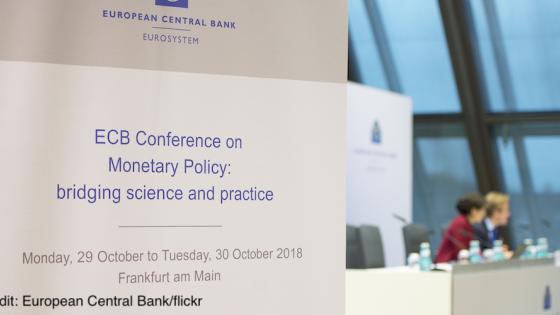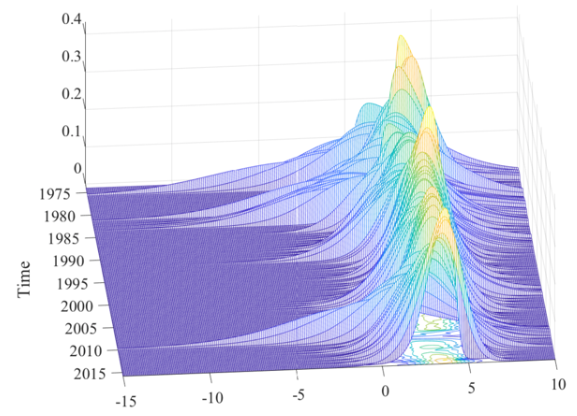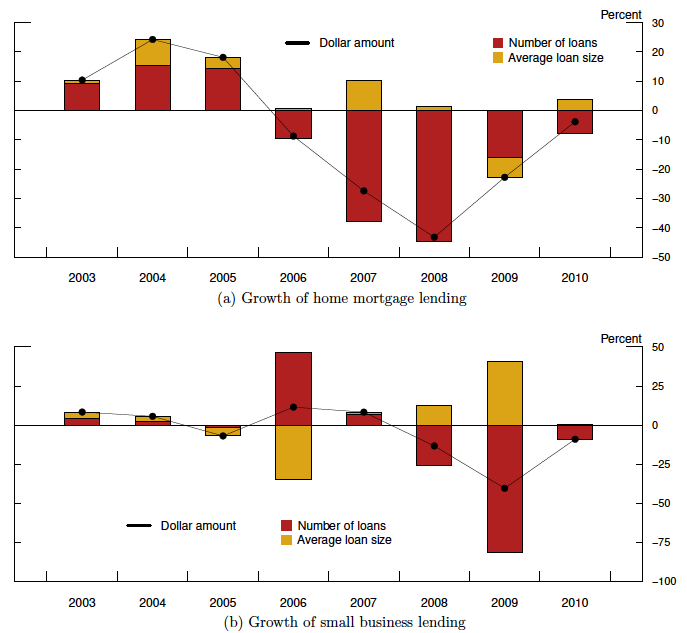“There has long been a symbiosis between practical central banking and academic research on monetary policy. […]. But while this symbiotic relationship continues, I believe that large potential gains from trade in ideas between practitioners and academics remain unexploited.” (Blinder 1997)
When Alan Blinder’s lecture “What Central Bankers Could Learn from Academics – and Vice Versa” was published in 1997, he could have not foreseen how strongly the “trade in ideas” would unfold in the years that followed, and especially over the last decade. The practitioners in central banks had to often jump ahead of what was enshrined in papers and textbooks and come up with untested approaches, such as large-scale asset purchases or negative interest rates, to tackle unprecedented threats to their monetary policy objectives.
Academic researchers in turn had to catch up by incorporating new tools and channels into their models. But also, independent of crisis-driven necessities, the ‘science’ side of monetary policy kept re-thinking, refining, and expanding models of the economy and the optimal conduct of monetary policy.
This exchange between academia and central banks is often most fruitful when it happens in person, when university researchers, central bank staff, and policymakers meet in the same place. "European Central Bank Conference on Monetary Policy: bridging science and practice" in October 2018 was such a forum. During the two days, conference participants would listen to a rich programme of speeches and academic presentations, and a policy panel.
Topics included the interaction of monetary policy and financial markets, the relevance of banks and credit flows for monetary policy transmission, and the current challenges for monetary policy frameworks and strategies.
Nobel laureate Chris Sims on the centrality of fiscal-monetary policy interactions
Chris Sims (Princeton University) highlighted in his address, titled “Current challenges for the science of monetary policy”, the need for monetary policymakers to be forward-looking in their analytical and policy focus rather than concentrating on “fighting the last war”. Central banks should additionally focus on monetary and fiscal interactions, a key theme in a future that will also require a research agenda around macroeconomic models that jointly capture monetary and fiscal policy.
This has been attempted in the past, but these models should now embody wealth effects on private sector expenditures, as this is a key channel for current and expected future fiscal policy impact on inflation. Suitable measures of fiscal expectations (taxes, social security, medical care) would be needed for such models, but these type of fiscal expectations appear to be captured less well by survey and market information than inflation expectations.
The link between monetary policy and financial markets: Manifold, and informative
The link between monetary policy and financial markets received a strong focus, in particular the role of financial market data for the risk assessment of future growth (‘financial conditions’), sectoral sources of finance, the duration channel of monetary policy, and the communication of central banks.
Challenges of capturing central bank communication also arose as a key theme. Refet Gürkaynak (Bilkent University) showed how to decipher financial markets’ perception of monetary policy communication using a novel data set. The Euro Area Monetary Policy Database comprises intraday information on interest rate swaps, sovereign yields, and exchange rates. This makes possible event studies on euro area monetary policy. Using the high frequency data in the database, the authors identify monetary policy target shocks from financial market responses around the time at which the ECB issues a press release following monetary policy meetings of the Governing Council. From asset price signals during the subsequent press conference, the authors identify two types of forward guidance factors shaping the yield curve, and a specific ‘QE factor’ since summer 2014.
The role of duration in today’s monetary policymaking was another key theme. Thomas King (Federal Reserve Bank of Chicago) described how the duration channel of quantitative easing policies can be embedded into central bank macro models. While numerous empirical studies have acknowledged that QE-type policies affect the yield curve beyond a potential policy rate signalling channel, several of the standard (micro-founded) models still see a ‘neutrality’ property of central bank bond purchases for long-term risk-free rates.
King’s paper derives the conditions and preference structures under which a change in the aggregate level of duration risk (and hence QE) can affect bond yields – a key insight for the specification and modification of DSGE models that try to incorporate such non-standard policies.
Beyond duration, discussions revolved around the comovement of stock prices and bond yields. Gregory Duffee (Johns Hopkins University) showed that, in the US, the correlation between stock returns and changes in nominal bond yields has been largely negative since the 1970s, but that this correlation has turned positive on average around 2000 – with a similar pattern in other major economies.
Inflation alone does not explain this phenomenon. There is a similar time-varying comovement between stock returns and changes in short-term real rates. The change in this comovement turns out to be unrelated to changing relations between the macroeconomy (output, inflation) and asset prices.
Finally, the role of exchange rates for monetary policy was examined through the lens of emerging market economies (EMEs). Hyun Song Shin (Bank for International Settlements) pointed out that the share of dollar-denominated credit to firms outside the US has shifted from banks to corporate bond markets, both worldwide and especially for EMEs. He also emphasised that the local currency sovereign bond market in EMEs has matured. Shin concluded that the increased reliance on local currency bonds has helped insulate monetary policy from global conditions, but only imperfectly. In a phase of capital inflow, EMEs would be subject to currency appreciation, undergo a period of subdued inflation and see strong credit-fuelled activity – and vice versa in an outflow phase.
There was a strong focus on the centrality of financial conditions for monetary policy. Tobias Adrian (IMF) presented the empirical finding that financial conditions are a key determinant of the conditional volatility of future real activity. He offered a parsimonious enhancement of the standard New Keynesian model to take into account financial vulnerability, and a financial accelerator channel.
The model generates skewed distributions of future output (with large negative surprises more probable) – compatible with empirically observed patterns (Figure 1). According to Adrian, central banks are advised to account for these endogenous risks when building models to help formulate monetary policy.
Figure 1 Distribution of GDP growth over time
Source: Reproduced from Adrian et al. (2018)
Notes: One-year-ahead predictive distribution of real GDP growth, based on quantile regressions with current real GDP growth and NFCI as conditioning variables.
Monetary policy, credit and banking: Turning the old into the new
Another highlight was the interplay between monetary policy and developments in credit aggregates and the banking system, from both a microeconomic and a macroeconomic perspective. In particular, analyses of the bank lending channel of monetary policy – with a focus on loans, lending rates, and funding conditions – and the transmission of monetary policy via banks, including the interaction with microprudential and macroprudential policies.
Regarding the prominence of interbank markets for monetary policy transmission, Harald Uhlig (University of Chicago) showed that interbank market uncertainty can have negative repercussions on bank lending. Using novel bank-level data, he showed that an increase in interbank rate uncertainty raises lending rates on loans to firms, with upward pressure peaking at around 100 basis points during the interbank market disruptions of the 2007-2009 Global Crisis and 2010-2012 European sovereign crisis.
He complemented the empirical evidence with a DSGE model featuring money-market frictions for banks, given by haircuts on secured loans by government bonds. These frictions affect the macroeconomy as banks divert resources into unproductive assets (bonds, money) or de-lever, and this in turn leads to a decline in lending and output.
The link between the quality of bank assets and monetary policy was tackled by José-Luis Peydro (Pompeu Fabra), who presented an empirical analysis based on a unique dataset comprising 15 credit registers from both euro area and non-euro area countries. He found that:
- Banks with higher ex-ante non-performing loans (NPLs) supply more credit toward riskier firms, with identical effects for banks headquartered in stressed and non-stressed countries.
- For banks operating in stressed countries only, centralised supervision compresses lending to riskier firms, although by a smaller extent for banks with higher NPLs. Effects are similar if only banks around the threshold of eligibility for centralised supervision are included, and effects are only significant after the centralisation of supervision.
- Monetary policy easing increases bank risk-taking but, in stressed countries, this is partly offset by centralised supervision, with weaker effects for banks with higher NPLs. Overall, results show that leveraging on multiple credit registers (as done in this paper for the first time) is important when analysing heterogeneous effects, and for external validity.
The macroeconomic relevance of home mortgage origination was another key topic. Egon Zakrajsek (Federal Reserve Board) analysed a comprehensive data set of home mortgage loan originations from HMDA, matched with bank income and balance sheet statements, to study how changes in the supply of mortgage credit influences economic conditions at the US county level.
The results indicate that, during periods of economic expansion, changes in the supply of home mortgage credit do not have material impact on county-level economic conditions such as house prices, employment, wages, and income. On the contrary, during downturns a contraction in mortgage driven by supply-side conditions has substantial adverse effects on county-level economic performance.
Figure 2 Decomposition of home mortgage and small business lending
Source: Gilchrist et al. (2018)
Notes: The red bars in each panel depict the growth of the number of loan originations (lending at the extensive margin), while the yellow bars depict the growth in the average loan size (lending at the intensive margin). The solid lines depict the growth of the dollar amount of loan originations (the sum extensive and intensive margins).
Atif Mian (Princeton University) spoke about the closely related theme of mortgage securitisation. He showed that the acceleration of private-label mortgage securitisation in US may have contributed to housing market speculation, bubbles and eventually mortgage default.
These conclusions were obtained by exploiting the global increase in shadow banking and private-label securitisation as a source of exogenous variation in credit supply at the local (US zip code) level. Mian estimated the effect of credit expansion on house prices, volume, and speculative trading activity by using a data set covering housing transactions, information on housing market optimism, and the characteristics of individuals obtaining new mortgages.
Monetary policy frameworks and strategies: Thinking the unconventional
The understanding of the role of confidence and expectations in shaping the economic outlook and for designing robust policy responses across different models was a common theme.
Ricardo Reis (LSE) highlighted intricacies that can arise if central banks were to use long rates as the main instrument. He drew lessons from past episodes of long-term interest-rate pegging.
Jonathan Wright (Johns Hopkins University) showed evidence that the responsiveness of long-term rates to changes in short-term rates has changed since the 1990s, with responsiveness having increased at high frequency and declined at low frequency. He drew attention to the stronger anchoring of long-term inflation expectations and search-for-yield motives as likely explanations.
Stephanie Schmitt-Grohé (Columbia University) argued that observing a long period of low interest rates and low inflation (or deflation) creates the possibility that the economy is in liquidity trap driven by sunspots, rather than by a sequence of fundamental shocks. This confronts policymakers with a challenging identification problem which can be very consequential because policy recommendations are opposite in the two cases. Faced with a liquidity trap driven by non-fundamental shocks, the policy advice would be to permanently increase interest rates as a way to bringing the economy out of the trap and lift inflation (the Neo-Fisherian effect).
Gauti Eggertsson (Brown University) argued the opposite view, that the Great Depression and the Great Recession were examples of liquidity-trap episodes driven by fundamental shocks. The policy advice in such circumstances would be to provide monetary policy accommodation, which may mean adopting price-level targeting, announcing a higher inflation target, and carrying out QE. He concluded that we need to combine the analysis of the long-run drivers behind low interest rates (such as demographics, inequality, technology slowdown) with short-run drivers (such as debt deleveraging cycles) if we want to enhance our understanding of the dynamics of liquidity traps.
Monetary policy challenges ahead: Views of central bankers, market participants, and academics
The final policy panel, moderated by ECB executive board member Peter Praet, featured Catherine Mann (Citi), Sims, Reis and Lars Svensson (Stockholm School of Economics). It focused on the policy relevance of Neo-Fisherian channels and on whether non-standard measures should become part of a 'new normal'.
Svensson opened the discussion by arguing that the Swedish central bank’s decision to tighten monetary policy in 2010 highlights the perils coming with “premature normalisation of the policy rate” and that “the Swedish experience provides no support for the Neo-Fisherian view”.
Participants noted positive effects for the economy from large-scale asset purchases, helping central bankers reach their objectives. But they also disagreed on the transmission of those QE-type policies.
- Sims emphasised that balance sheet expansions of central banks had been important because some financial market segments had essentially been frozen, but that large-scale asset purchases may have had a more subdued effect.
- Mann acknowledged the effectiveness of large-scale asset purchases, but argued that transmission channels had not always worked in the ways that had been expected ex ante. For instance, she stressed that some US households were not able to benefit from lower mortgage rates as the new regulatory environment stopped them getting new loans, or were not benefiting from the low-rate environment as credit card rates had not decreased much.
- Praet emphasised that the ECB’s asset purchases – together with other non-standard policies like negative interest rates – stabilised the key risk-free curves in the euro area and thus helped in providing accommodative financial conditions. Addressing the concern that a large balance sheet may expose the ECB to undesirable political pressure, he emphasised the need to keep the counterfactual in mind – if the ECB had not taken recourse to such bold but controversial instruments, it may have failed to deliver on its mandate.
- Sims expressed some scepticism on the effectiveness of negative rates, as they may act like a ‘tax on banks’, especially if they are not accompanied by adequately expansionary fiscal policy. He also welcomed the existence of a lower bound for interest rates as otherwise – referencing to the framework that Stephanie Schmitt-Grohé had introduced – a negative deflationary spiral could not be excluded.
- Svensson explained that Swedish banks were able to cope well with negative rates. Frank Smets (in the audience) argued that, ceteris paribus, negative interest rates would have an impact on bank profits, as lending rates decrease while deposit rates are subject to a lower bound. However, lower lending rates have a stimulating effect on the economy, which in turn benefits bank profitability, and so the negative and positive effects on bank profitability would largely cancel out. At the same time, the balance of such effects would depend on how long a negative rates environment would persist.
So, what are the future tools for central banks? Participants focused mainly on the size and composition of central bank balance sheets.
- Sims asserted that central banks should not maintain large balance sheets for too long, inter alia as political economy risks can emerge and central bank independence may be endangered, especially in case of large-scale valuation losses. Moreover, central banks need to have enough capacity to engage in large-scale interventions if another negative shock hit the economy.
- Reis favoured a central bank balance sheet composed of short-term assets that would be just as sizeable, so that monetary policy can guarantee a structural liquidity surplus to control short-term interbank market rates.
Finally, in response to a question from Uhlig, Reis stressed that several of the insights from the conference presentations and panel discussions would need to be revisited ten years from now if the economy had turned cashless. For example, the identification, monitoring and relevance of loan supply shocks would need to be re-thought in such an economy, with potentially different and new forms of credit provision and intermediation.
Outlook
Blinder (1997) testified “that central banking in practice is as much art as science”. Recently the art was probably in the decisions of central banks to leave, modify or re-think existing ideas of best policy responses. At the ECB’s monetary policy department, this conference was valuable as it helped us shape our thinking of how to evaluate past policy actions – including new tools and transmission channels – and how to systematise our learning so that they can be helpful for policy challenges ahead.
We plan to repeat this conference in a similar format in the coming years. While we may accentuate different themes every year, we will stick to providing a forum in which academic research meets the practice of central banking.
Editors’ note: The conference programme with links to several presentations, a recording of the policy panel, and one-minute flash interviews with presenters can be found here.
References
Adrian, T, N Boyarchenko and D Giannone (2018), “Vulnerable growth”, forthcoming in American Economic Review.
Adrian, T and F Duarte (2018), “Financial vulnerability and monetary policy”, Federal Reserve Bank of New York Staff Reports 804.
Adrian, T, F Duarte, N Liang and P Zabczyk (2018), “Monetary policy with endogenous risk”, mimeo.
Adrian, T, F Grinberg, N Liang and S Malik (2018), “The term structure of growth at risk”, IMF Working Paper 18/180.
Altavilla, C, M Boucinha, J-L Peydró and F Smets (2018), “Banking supervision, monetary policy and risk-taking: big data evidence from 15 credit registers”, mimeo.
Altavilla, C, L Brugnolini, R S Gürkaynak, R Motto and G Ragusa (2018), “Measuring euro area monetary policy”, mimeo.
Altavilla, C, G Carboni, M Lenza and H Uhlig (2018), “Interbank uncertainty and bank lending”, mimeo.
Benhabib, S, S Schmitt-Grohé and M Uribe (2001), “The perils of Taylor Rules”, Journal of Economic Theory 96(1-2): 40-69.
Blinder, A S (1997), “Distinguished lecture on economics in government: what central bankers could learn from academics--and vice versa”, Journal of Economic Perspectives 11(2): 3-19.
De Fiore, F, M Hoerova and H Uhlig (2018), “Money markets, collateral and monetary policy”, NBER Working Paper 25319.
Duffee, G R (2018), “Expected inflation, real rates, and stock-bond co-movement”, mimeo.
Eggertsson, G and P Krugman (2012), “Debt, deleveraging, and the liquidity trap: a Fisher-Minsky-Koo approach”, The Quarterly Journal of Economics 127(3): 1469-1513.
Eggertsson, G and M Woodford (2003), “The zero bound on interest rates and optimal monetary policy”, Brookings Papers on Economic Activity 34(1): 139-235.
Gilchrist, S, M Siemer and E Zakrajšek (2018), “The real effects of credit booms and busts”, mimeo.
Hanson, S, D Lucca and J Wright (2018), “The excess sensitivity of long-term rates: a tale of two frequencies”, FRB of NY Staff Report 810.
Hofmann, B, I Shim and H S Shin (2017), “Sovereign yields and the risk-taking channel of currency appreciation”, BIS Working Paper 538.
Hofmann, B, H S Shin and M Villamizar-Villegas (2018), “Unintended effects of sterilized foreign exchange intervention”, BIS Working Paper.
King, T B (2015), “A portfolio-balance approach to the nominal term structure”, FRB of Chicago Working Paper 2013-18.
Mian, A and A Sufi (2018), “Credit supply and housing speculation”, NBER Working Paper 24823.
Reis, R (2018a), “Central banks going long”, forthcoming in Monetary Policy and Financial Stability: Transmission Mechanisms and Policy Implications.
Reis, R (2018b), “The people versus the markets: inflation and monetary policy”, mimeo.
Schmitt-Grohé, S and M Uribe (2017), “Liquidity traps and jobless recoveries”, American Economic Journal: Macroeconomics 9(1): 165–204.
Schmitt-Grohé, S and M Uribe (2014), “Liquidity traps: an interest-rate-based exit strategy”, The Manchester School.
Svensson, L E O (2011), “Practical monetary policy: examples from Sweden and the United States”, Brookings Papers on Economic Activity, Fall 2011: 289-332.
Svensson, L E O (2018), “The future of monetary policy and macroprudential policy”, paper prepared for “The future of central banking: an ECB colloquium held in honour of Vitor Constancio”: 69-123.
Uribe, M (2018), “The neo-Fisher effect: econometric evidence from empirical and optimizing models”, NBER Working Paper 25089.









